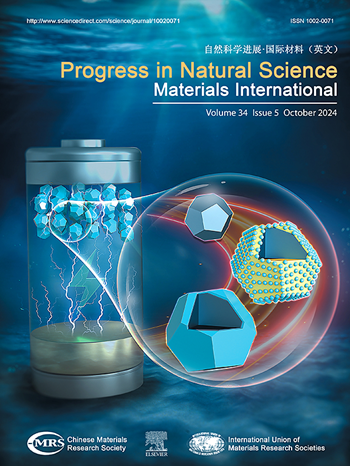Regulation of charge density wave and superconductivity in kagome superconductor CsV3Sb5 by intercalation
IF 7.1
2区 材料科学
Q2 MATERIALS SCIENCE, MULTIDISCIPLINARY
Progress in Natural Science: Materials International
Pub Date : 2025-02-01
DOI:10.1016/j.pnsc.2024.11.001
引用次数: 0
Abstract
AV3Sb5 (A = K, Rb, and Cs), recently discovered van der Waals Kagome metals, exhibit a multitude of intriguing strongly correlated phenomena, particularly the unconventional charge density wave (CDW) and superconductivity, and thus have generated tremendous attention. In this study, we modulated CDW orders and superconductivity in CsV3Sb5 flakes utilizing an ionic-gel electrolyte (LiClO4/PEO), which also serves as a protective layer to prevent the CsV3Sb5 thin flakes from being degraded in air. The dominated carriers of pristine CsV3Sb5 undergoes a transition from electron-type above 50 K to hole-type below 10 K, while both electron and hole carriers participate in the transport process at 25 K. The CDW transition temperature increases (from 86 K up to 106 K) and behaves a positive correlation with the electron-type carrier concentration, while the superconducting transition temperature decreases and behaves a negative correlation with the hole-type carrier concentration. The regulation of carrier density induces a shift in the relative positions of Fermi level and van Hove singularities, leading to the modulation of CDW order and superconductivity. Our work demonstrates CsV3Sb5 as a versatile platform for tuning CDW order and superconductivity, and provides valuable insights into the physical properties of Kagome metals.
插层对kagome超导体CsV3Sb5中电荷密度波和超导性的调控
AV3Sb5 (A = K, Rb, Cs)是最近发现的范德瓦尔斯-卡戈梅金属,表现出许多有趣的强相关现象,特别是非常规电荷密度波(CDW)和超导性,因此引起了极大的关注。在这项研究中,我们利用离子凝胶电解质(LiClO4/PEO)调节CsV3Sb5薄片的CDW顺序和超导性,该电解质还作为保护层防止CsV3Sb5薄片在空气中降解。原始CsV3Sb5的主导载流子在50 K以上经历了电子型向10 K以下空穴型的转变,而在25 K时电子和空穴载流子都参与了输运过程。CDW转变温度升高(从86 K升高到106 K),与电子型载流子浓度呈正相关,超导转变温度降低,与空穴型载流子浓度负相关。载流子密度的调节导致费米能级和范霍夫奇点的相对位置发生位移,从而导致CDW阶和超导性的调制。我们的工作证明了CsV3Sb5是一个通用的平台,可以调节CDW的顺序和超导性,并为Kagome金属的物理性质提供了有价值的见解。
本文章由计算机程序翻译,如有差异,请以英文原文为准。
求助全文
约1分钟内获得全文
求助全文
来源期刊
CiteScore
8.60
自引率
2.10%
发文量
2812
审稿时长
49 days
期刊介绍:
Progress in Natural Science: Materials International provides scientists and engineers throughout the world with a central vehicle for the exchange and dissemination of basic theoretical studies and applied research of advanced materials. The emphasis is placed on original research, both analytical and experimental, which is of permanent interest to engineers and scientists, covering all aspects of new materials and technologies, such as, energy and environmental materials; advanced structural materials; advanced transportation materials, functional and electronic materials; nano-scale and amorphous materials; health and biological materials; materials modeling and simulation; materials characterization; and so on. The latest research achievements and innovative papers in basic theoretical studies and applied research of material science will be carefully selected and promptly reported. Thus, the aim of this Journal is to serve the global materials science and technology community with the latest research findings.
As a service to readers, an international bibliography of recent publications in advanced materials is published bimonthly.

 求助内容:
求助内容: 应助结果提醒方式:
应助结果提醒方式:


